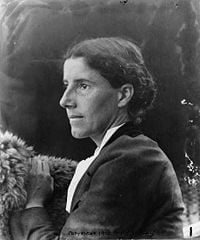Charlotte Perkins Gilman
Charlotte Perkins Gilman (July 3 1860 – August 17 1935) was a prominent American non-fiction writer, short story writer, novelist, commercial artist, lecturer, and social reformer. She is mainly known today for her short story "The Yellow Wallpaper," based on her own bout with mental illness and misguided medical treatment.
Biography
Early life and first marriage
Gilman was born Charlotte Anna Perkins in Hartford, Connecticut, the daughter of Mary Perkins (formerly Mary Fitch Westcott) and Frederic Beecher Perkins, a well-known librarian and magazine editor, and nephew of Harriet Beecher Stowe. Her father abandoned the family, leaving his wife and daughter with his progressive aunts Harriet Beecher Stowe, Catharine Beecher, and Isabella Beecher Hooker
After two years at the Rhode Island School of Design, Gilman supported herself as a greeting-card artist. She married Charles Walter Stetson, a fellow artist, in 1884, and her only child, Katharine Beecher Stetson, was born the same year. During this time—and throughout her life—she suffered from depression, which influenced her writing.
She separated from her husband in 1888 (and divorced him six years later), and moved with her daughter to California, where she was active in organizing for social reform movements; she lectured across the country and in the United Kingdom. Her daughter subsequently went to live with her ex-husband and his second wife, Ellery Channing, who was also her best friend.
For a time she lived in a so-called Boston marriage with Adeline Knapp, a San Francisco newspaper reporter who shared her interests in social reform and the Nationalist Club, based on Edward Bellamy's socialist utopian vision.
Writing and lecturing
Perkins Gilman had gained international fame with the publication of Women and Economics in 1898. It was widely read in both North America and Europe and was subsequently tanslated into seven languages. The premise of the book states that maternal and domestic roles are overemphasized for women and true freedom comes in the form of economic liberation for a woman. Its philosophy reflects Gilman's view of a utopian society and the influence of both Marixt theory and Social Darwinism.
Her second marriage—from 1900 to his death in 1934—was to her first cousin, New York lawyer George Houghton Gilman.
In 1909 Gilman founded the literary magazine, "Forerunner," which published short stories, essays and book reviews. It also serialized Gilman's novels: Herland a romantic utopian novel, whose story line was influenced by Edward Bellamy's own utopian novel Looking Backward. In 1915 she founded the Women's Peace Party along with Jane Addams.
End of Life
In 1922, Gilman moved from New York to Norwich, Connecticut, where she wrote her social critique, the book His Religion and Hers. According to one biographer, Gilman was a Deist and "she foresaw that women... would someday form a religion that would focus on crating a paradise on earth.
Ten years later, having moved back to Pasadena—following the death of her husband (1934), and in order to be closer to her daughter—she was diagnosed with breast cancer. The cancer was inoperable, and she committed suicide on August 17 1935, by inhaling chloroform. Her autobiography, The Living of Charlotte Perkins Gilman was published posthumously.
Critical appreciation
"The first duty of a human being is to assume the right functional relationship to society — more briefly, to find your real job, and do it."
Bibliography
- The Yellow Wallpaper (1890)
- In This World (1893)
- Women and Economics (1898)
- Concerning Children (1900)
- The Home, Its Work And Influence (1903)
- Human Work (1904)
- Forerunner (magazine)|Forerunner (monthly journal with prose - 1909-1916)
- The Crux (1910)
- Moving the Mountain (1911)
- The Man-Made World; or, Our Androcentric Culture (1911)
- Our Brains and What Ails Them (1912)
- Humanness (novel)|Humanness (1913)
- Benigna Machiavelli (1914)
- Social Ethics: Sociology and the Future of Society (1914)
- The Dress of Women (1915)
- Herland (novel)|Her Land (1915)
- Growth and Combat (1916)
- With Her in Our Land (1916)
- His Religion and Hers (1922)
- What Diantha Did
- The living of Charlotte Perkins Gilman: an autobiography (posthumous - 1987)
Notes
ReferencesISBN links support NWE through referral fees
- The New Encyclopedia Britannica "Gilman, Charlotte Anna Perkins." Vol. 5 2002.
- "Charlotte Perkins Gilman." Historic World Leaders. Gale Research, 1994. Reproduced in Biography Resource Center. Farmington Hills, Mich.: Thomson Gale. 2007.
- "Charlotte Perkins Gilman." American Decades. Gale Research, 1998. Reproduced in Biography Resource Center. Farmington Hills, Mich.: Thomson Gale. 2007.
- Charlotte Perkins Gilman:The Yellow Wallpaper and Other Stories, edited with an introduction by Robert Shulman. Oxford World's Classics, 1998.
External links
- Works by Charlotte Perkins Gilman. Project Gutenberg, Retrieved April 4, 2007.
- "Similar Cases by Charlotte Gilman", About, Retrieved April 4, 2007.
- "Charlotte Perkins Gilman", Books and Writers, Retrieved April 4, 2007.
| Persondata | |
|---|---|
| NAME | Gilman, Charlotte Perkins |
| ALTERNATIVE NAMES | |
| SHORT DESCRIPTION | American Short story and non-fiction writer, novelist, commercial artist, lecturer and social reformer. |
| DATE OF BIRTH | July 4, 1860 |
| PLACE OF BIRTH | Hartford, Connecticut |
| DATE OF DEATH | August 17, 1935 |
| PLACE OF DEATH | Pasadena, California |
Credits
New World Encyclopedia writers and editors rewrote and completed the Wikipedia article in accordance with New World Encyclopedia standards. This article abides by terms of the Creative Commons CC-by-sa 3.0 License (CC-by-sa), which may be used and disseminated with proper attribution. Credit is due under the terms of this license that can reference both the New World Encyclopedia contributors and the selfless volunteer contributors of the Wikimedia Foundation. To cite this article click here for a list of acceptable citing formats.The history of earlier contributions by wikipedians is accessible to researchers here:
The history of this article since it was imported to New World Encyclopedia:
Note: Some restrictions may apply to use of individual images which are separately licensed.

